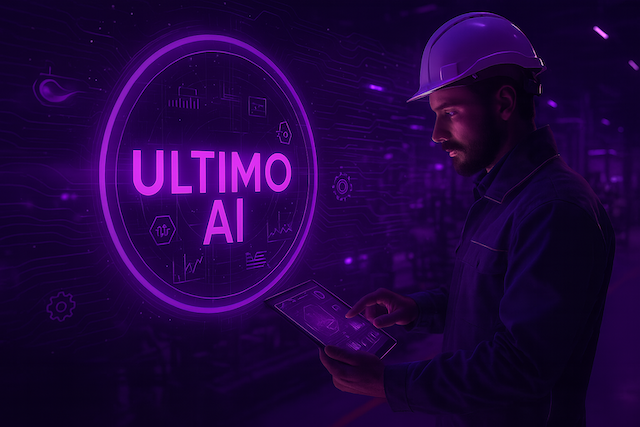
Industrial operations face an unprecedented crisis that threatens operational continuity across global markets. According to our Maintenance Trend Report, 63 percent of organizations consider the aging workforce as their most pressing maintenance challenge. Half (50 percent) are struggling to recruit experienced staff. The foundation of industrial expertise is rapidly eroding. This skills shortage directly impacts what matters most in asset management: operational uptime. Even the briefest disruption has expensive consequences, and with millions in lost productivity and safety incidents looming, the stakes are high. The convergence of workforce challenges with mounting pressure for efficiency has created a perfect storm that demands improvements.
Part of the answer lies in agentic artificial intelligence (AI) – autonomous digital workers that don’t just respond to commands but proactively optimize operations around the clock. Unlike traditional AI tools that require constant human oversight, agentic AI in Enterprise Asset Management (EAM) represents a fundamental shift toward autonomous systems that function as specialized experts, learning from every interaction and taking initiative to prevent breakdowns before they happen.
The Critical Gap in Industrial Operations
The magnitude of workforce challenges in industrial maintenance cannot be overstated. Our industry research reveals that almost half (49 percent) of industrial businesses lack the internal expertise required to adopt advanced technologies like AI. This creates a paradox: the organizations that need innovation most are least equipped to implement it. This expertise gap extends beyond simple technical knowledge to encompass the deep operational understanding required to maintain complex industrial assets effectively.
The consequences of this skills crisis extend far beyond staffing concerns. According to the International Labour Organization, over 2.3 million workers die annually due to occupational accidents or work-related diseases. This figure is likely much higher due to limited enforcement capacity and communication gaps. When experienced workers retire, decades of institutional knowledge walks out the door. Everything they know about equipment behavior, failure patterns, and operational nuances is difficult to document or transfer.
Traditional EAM systems, designed as passive repositories of information, are evolving to address these challenges proactively.
The Evolution to Agentic AI in EAM
Agentic AI supports a paradigm shift from reactive to proactive asset management. These systems function as digital coworkers embedded within organizational workflows, continuously learning from interactions and taking autonomous action to optimize operational efficiency. Unlike conventional AI tools that provide recommendations or insights, agentic AI systems make decisions, execute tasks, and adapt their behavior based on outcomes.
The transformation is particularly evident in health, safety, and environmental (HSE) compliance, where underreporting of incidents has long plagued industrial operations. AI agents can autonomously identify and log incidents from work orders, reinforcing safety measures that would otherwise go unnoticed. This capability addresses a critical operational challenge where communication gaps and information deficits contribute to both safety risks and operational inefficiencies.
The autonomous nature of these agents means they operate continuously, monitoring conditions, analyzing patterns, and taking preventive action with minimal human intervention. This represents a fundamental evolution from EAM systems as passive tools to active participants in operational management. The implications far exceed efficiency gains to encompass new levels of operational intelligence and responsiveness.
Specialized Expertise Through Digital Coworkers
Digital coworkers provide specialized expertise across multiple domains. These agentic systems are designed to handle specific operational challenges, from incident reporting and work order management to improving predictive maintenance strategies and inventory optimization. Each digital coworker functions as a domain expert, bringing deep knowledge and continuous learning capabilities to their assigned responsibilities.
Intelligent asset cataloging represents one application where agentic AI demonstrates its value. Through machine learning algorithms, these systems automatically structure assets by conducting smart interviews, connecting Excel files, technical manuals, photographs, and facility data into coherent operational pictures. This capability eliminates the manual effort traditionally required to maintain accurate asset inventories while ensuring information consistency across operations.
The predictive maintenance capabilities of agentic AI systems integrate real-time sensor data with historical patterns to optimize maintenance scheduling and predict equipment failures. This proactive approach shifts maintenance from reactive responses to strategic interventions, reducing downtime and extending asset lifecycles. The system’s ability to learn from every moment of maintenance means its predictions become increasingly accurate over time.
Computer vision integration further enhances operational capabilities by enabling mobile-based parts identification and automated inventory management through image recognition. By taking a picture on their mobile device, technicians can access relevant information, order replacements, or update inventory records. This streamlines field operations and reduces administrative burden.
Transforming HSE Compliance and Operational Safety
The application of agentic AI to HSE compliance represents a significant advancement in operational safety management. Traditional incident reporting relies heavily on manual input and human judgment, leading to inconsistencies and underreporting that compromise safety outcomes. Digital co-workers can analyze work orders, maintenance logs, and operational data to identify potential safety incidents that might otherwise go unnoticed.
Autonomous incident identification is particularly valuable in complex industrial environments where multiple activities occur simultaneously. The system can correlate seemingly unrelated events, identify patterns that suggest safety concerns, and automatically trigger appropriate reporting and response protocols. This level of continuous monitoring and analysis would be impossible to achieve through manual oversight alone.
The learning capabilities of agentic AI systems mean they become increasingly sophisticated in their ability to identify safety risks and compliance issues. As they process more data and observe more operational scenarios, they develop a deeper understanding of the conditions that lead to incidents, enabling more effective prevention strategies. This continuous improvement cycle creates a feedback loop that enhances safety performance over time.
Enterprise-Ready Architecture for Industrial Deployment
The practical implementation of agentic AI in industrial environments requires robust, enterprise-grade architecture designed to meet operational demands. EAM platforms with fully embedded, purpose-built AI agents eliminate dependencies on external AI platforms. They reduce complexity and potential security vulnerabilities, while ensuring system reliability. This approach contrasts with generic AI solutions that may require extensive customization, training or integration work.
Seamless integration within existing EAM workflows ensures that agentic AI systems enhance rather than disrupt established operational processes. Organizations can deploy these capabilities without workflow disruption or system migration, maintaining operational continuity while gaining advanced AI functionalities. This integration approach recognizes that industrial operations cannot afford extended implementation periods or learning curves.
Easy to start, organizations can scale their AI capabilities based on actual usage and demonstrable value, rather than making large upfront investments in uncertain technology. This approach aligns AI adoption with operational needs and budget constraints.
By integrating information from multiple sources such as sensors, maintenance logs, work orders, and compliance reports, agentic AI systems develop comprehensive operational understanding that enables more accurate decision-making. This holistic view of operations is essential for effective asset management.
Mobile-first design ensures that agentic AI capabilities are accessible in wherever they have most impact, which is often in the field where much industrial maintenance occurs. Technicians can access AI insights, receive guidance, and input information through mobile devices. This creates the perfect fusion between digital intelligence and hands-on operational work.
Proven Results and Future Potential
Importantly, the use of agentic AI in EAM is no longer theoretical. Maintenance professionals from global industrial organizations are already benefiting from collaborating with their digital coworkers. These deployments will lead to significant reductions in downtime, improved safety compliance, and enhanced operational efficiency.
The scalable architecture of modern agentic AI systems ensures that capabilities can grow with business needs without requiring excessive investment. Organizations can start with focused applications and expand their AI utilization as they gain experience and confidence. This scalability is particularly important for industrial operations that may have varying seasonal demands or growth trajectories.
The future of agentic AI is as exciting as it is astounding. Agents could eventually manage entire aspects of maintenance operations, from planning and scheduling to warehouse coordination and supplier management. This evolution toward fully autonomous maintenance management represents a fundamental transformation in how industrial operations are conducted.
The Path Forward
The convergence of workforce challenges, technological advancement, and operational demands creates a unique opportunity for industrial organizations to reimagine their approach to asset management. Agentic AI provides a path forward that addresses immediate skills shortages while offering a stepping stone for future technological innovation.
The key to success lies in recognizing that agentic AI is not simply another tool to be managed, but rather a new f operational partner that can take initiative, learn from experience, and contribute to organizational excellence. This perspective shift is essential for realizing the full potential of AI in industrial environments.
As organizations begin their journey toward agentic AI adoption, the focus should be on building capabilities that enhance human expertise rather than replacing it. The goal is to create environments where AI handles routine operations so human experts can focus on complex problem-solving, strategic planning, and innovation. This collaborative approach between human intelligence and artificial intelligence represents the future of industrial operations.
The transformation of EAM through agentic AI is not just about technology. It’s about creating more resilient, efficient, and safe industrial operations. A step up so that organizations can thrive despite workforce challenges and increasing operational complexity. The organizations that embrace this transformation will be best positioned to maintain competitive advantage in an increasingly challenging industrial landscape.





